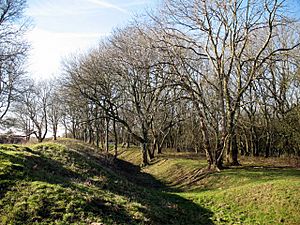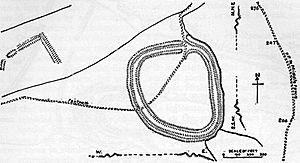Cadbury Camp facts for kids
Quick facts for kids Cadbury Camp |
|
|---|---|

Tree growth on the ramparts at Cadbury Camp
|
|
| Location | Tickenham, Somerset, England |
| OS grid reference | ST 45406 72467 |
| Built | Iron Age |
| Official name: Cadbury Camp | |
| Designated | 17 October 1930 |
| Reference no. | 1008295 |
| Lua error in Module:Location_map at line 420: attempt to index field 'wikibase' (a nil value). | |
Cadbury Camp is an ancient hill fort located in Somerset, England, near the village of Tickenham. It was built during the Iron Age, a time when people started using iron tools and weapons. Today, it is protected as a scheduled monument, which means it's an important historical site.
While Cadbury Camp is mostly known as an Iron Age fort, archaeologists have found older items there, like a bronze spear or axe head. This suggests the site was first used even earlier, during the Bronze Age. People likely continued to live there through the Roman period and into the time after the Romans left Britain, when the area was part of a Celtic kingdom.
The name "Cadbury" might come from "Cada's byrig." Byrig is an old Anglo-Saxon word meaning "fort" or "town." Some people think the name could also mean "Fort of Cador." Cador might have been a local king or leader in the 5th century who controlled parts of Somerset, Bristol, and South Gloucestershire. He is sometimes linked to the legends of King Arthur, but this is mostly from old stories and not solid historical proof.
This 7-acre (2.8 ha) hill fort is very well preserved. The National Trust, a group that protects historic places, helps look after it. They work with Natural England to manage the site, which includes removing certain trees like non-native Turkey Oaks and looking after the scrub.
Cadbury Camp is one of three places in Somerset with "Cadbury" in its name. The others are Cadbury Castle, near South Cadbury, and Cadbury Hill, also known as Cadbury-Congresbury.
Location of Cadbury Camp
Cadbury Camp sits on a natural ridge, which is like a long, narrow hill. It's located between the Gordano Valley and the North Somerset Levels, which are low, flat areas. Next to the fort is Limebreach Wood, an ancient woodland and nature reserve.
History of the Fort
The hill fort was built during the Iron Age, probably by a local tribe called the Dobunni. We don't know all the details about how it was built. However, finding a bronze spear or axe head at the site tells us that people were using this spot even before the Iron Age. This Bronze Age spearhead is now kept at the Museum of Somerset in Taunton.
Hill forts like Cadbury Camp became common in Britain around 1000 BC. They were often built as defensive sites, perhaps to protect communities during times of conflict or to show the power of local leaders. The fort at Cadbury Camp covers about 7 acres (2.8 ha). It had ditches and earth banks, likely topped with a wooden fence, all built on high ground above the marshy land below. The main earth banks are about 45 feet (14 m) apart. The fort stretches about 190 metres (620 ft) from north to south and 160 metres (520 ft) from east to west. The ditch is around 2 metres (6 ft 7 in) deep, and the earth banks rise about 1.5 metres (4 ft 11 in).
After the Iron Age, people may have continued to live at Cadbury Camp into the Roman era. This is suggested by discoveries like pieces of pottery, a small stone statue of Mars (the Roman god of war), and Roman coins. The site might even have been used into the Anglo-Saxon period. Many of these finds were uncovered during excavations in 1922 by a person named Harold St George Gray. A coin from around 370 AD was found in 1945, and a Romano-British stone carving was discovered in 1974. This carving is now at the Weston Museum.
During World War II, Cadbury Camp was used for bomb disposal and as a place for a searchlight battery, which helped spot enemy aircraft at night.
Looking After Cadbury Camp
Cadbury Camp used to be part of the land belonging to Clevedon Court. Today, the National Trust manages the site. They have an agreement with Natural England to help protect it. This includes removing trees whose roots are growing into the old earth banks, which can damage them. They especially remove non-native Turkey Oaks because these trees can attract damaging Gall wasps. They also use cattle to graze the land, which helps control the scrub and encourages wildflowers like orchids to grow.
Myths and Legends
Some local stories connect Cadbury Camp with King Arthur and his legendary castle, Camelot. However, these stories might be due to confusion with the much more famous Cadbury Castle, which is about 50 miles to the south and has stronger links to the Arthurian legends.



